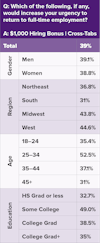Most Appealing Incentive to Hesitant-to-Return Workers, New U.S. Chamber Poll Shows
WASHINGTON, D.C. –Hiring bonuses are an effective instrument to encourage more unemployed, Americans to return to work, new polling data released today by the U.S. Chamber of Commerce shows. The survey results reveal some of the most impactful and immediate solutions employers and elected officials can deploy in helping address the country’s deepening worker shortage crisis.
Nearly four in 10 (39%) unemployed Americans who lost their jobs during the pandemic and are not actively looking for work say that a $1,000 hiring bonus would increase their urgency to return to full-time employment—the most commonly cited response. Other incentives or developments that would encourage unemployed Americans to re-enter the workforce include work-from-home flexibility (32%) and worker vaccination requirements (23%)
The percentage who say hiring bonuses could attract them back to the job market was particularly high among unemployed workers age 25-34 (53%) and those with some college education but not a degree (49%). The share was also relatively high among unemployed Americans in West (45%) and Midwest (44%) regions of the country.

“One of several important and immediate steps governors can take in encouraging unemployed, hesitant-to-return Americans to rejoin the workforce is investing federal relief funds in hiring incentive programs like return-to-work bonuses,” said Neil Bradley, executive vice president and chief policy officer, U.S. Chamber of Commerce. “Too many businesses and communities across the nation continue to suffer amid the growing worker shortage. We are calling on every governor to take immediate action to help bring more Americans back into the workforce.”
Recently, ten states—Arizona, Colorado, Connecticut, Kentucky, Maine, Michigan, Montana, New Hampshire, Oklahoma, Virginia—have announced return-to-work-bonus offerings or similar financial incentives for workers to rejoin the labor force. Six of these states have Democratic governors, while four have Republican governors.
The U.S. Chamber of Commerce has commended those actions and encouraged more governors to consider using American Rescue Plan Act resources to help fund return-to-work bonuses. Several other states are currently considering taking similar measures.
This polling follows U.S. Chamber analysis of federal employment data that show a steadily worsening workforce crisis. The latest U.S. Chamber’s Workforce Availability Ratio showed that there are now half as many available workers for every open job (1.4 available workers/opening) across the country as there have been on average over the past two decades (2.8 historical average). In total, there were more than 9.3 million job openings available at the end of April—a record high and a staggering 1-million-openings increase from March.
"America’s great economic resurgence is being held back by an unprecedented workforce shortage—and it’s getting worse,” Bradley said. “We are seeing an increasing number of businesses turning down work and only partially reopening because they can’t find enough workers.”
The U.S. Chamber of Commerce and the U.S. Chamber of Commerce Foundation recently launched America Works, a nationwide initiative mobilizing industry and government to swiftly address America’s deepening worker shortage crisis. Discover workforce solutions, find additional research and analysis, and explore the full America Works policy agenda at uschamber.com/work.
This poll of 506 Americans who lost jobs during the pandemic and have not returned to full-time employment was taken May 17-20. The poll has an overall survey margin of error +/-4.4 at the 95% confidence level, with stable and projectable bases across age, prior total compensation, ethnicity, incidence of children at home, industry sector and educational attainment.





